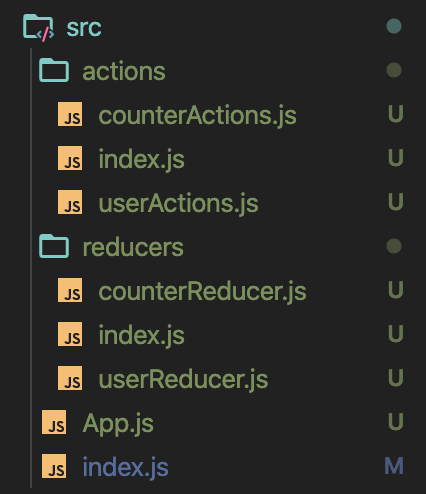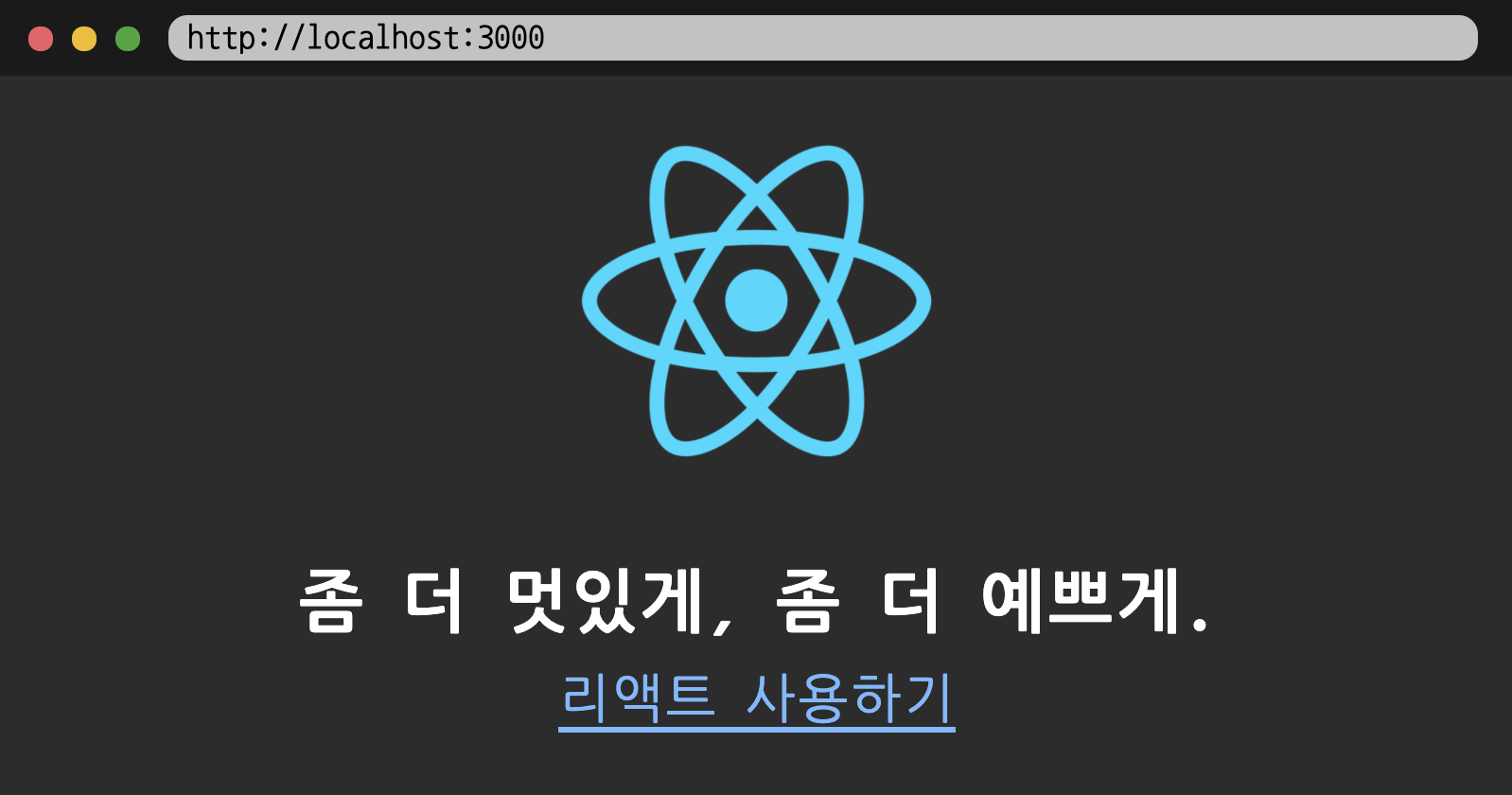React + Redux
지난번엔 바닐라 JS에서 Redux를 이용하여 상태관리를 해봤어요.
이 친구를 React에 적용하면, class형 컴포넌트를 사용하지 않고도 각각의 파일에서 state 관리가 가능해집니다.
간단한 카운터 앱과 로그인 기능을 리덕스로 구현해볼게요!
파일 구조는 아래와 같아요.

actions
actions 폴더에 있는 친구들은 dispatch의 인자로 줄 action 객체를 생성해요.
바닐라 JS + Redux에서 배웠듯이, action 객체엔 type이란 키가 꼭 필요하죠?
이 type은 reducer 내부에서 switch-case 구문의 조건이 돼요.
먼저 counterActions.js를 봅시다.
increment(), decrement() 함수를 정의하고, 각각 type이 포함된 객체를 리턴해요.
src/actions/counterActions.js
const increment = () => {
return {
type: "INCREMENT"
};
};
const decrement = () => {
return {
type: "DECREMENT"
};
};
export default {
increment,
decrement
};userActions.js는 사용자의 정보가 포함된 객체를 리턴해요.
src/actions/userActions.js
const loginUser = user => {
return {
type: "LOG_IN",
user
};
};
const logoutUser = () => {
return {
type: "LOG_OUT"
};
};
export default {
loginUser,
logoutUser
};index.js에서 이 친구들을 하나로 묶어줍니다.
src/actions/index.js
import counterActions from "./counterActions";
import userActions from "./userActions";
const allActions = {
counterActions,
userActions
};
export default allActions;추후 allActions.counterActions.increment()로 호출하게 되면 { type: "INCREMENT" } 객체가 리턴돼요.
이 친구가 dispatch 함수의 인자로 가서 reducer에 전달된다면 상태 업데이트가 일어나겠죠?
reducers
reducers에선 상태를 생성하고 관리에 들어가요.
actions 폴더에서 생성된 객체들이 reducer 함수의 인자 action으로 들어가는거예요.
src/reducers/counterReducer.js
const counter = (state = 0, action) => {
switch (action.type) {
case "INCREMENT":
return state + 1;
case "DECREMENT":
return state - 1;
default:
return state;
}
};
export default counter;userReducer.js도 크게 다르지 않습니다.
action.type에 따라 데이터를 state에 넣어주는 역할을 해요.
대신 여기선 state의 불변성을 지켜주어야 합니다!!
src/reducers/userReducers.js
const currentUser = (state = {}, action) => {
switch (action.type) {
case "LOG_IN":
return { ...state, user: action.user, login: true };
case "LOG_OUT":
return { ...state, user: "", login: false };
default:
return state;
}
};
export default currentUser;index.js에선 combineReducers()를 사용해 두 리듀서를 하나로 정의해줍니다.
src/reducers/index.js
import counter from "./counterReducer";
import currentUser from "./userReducer";
import { combineReducers } from "redux";
const rootReducer = combineReducers({ counter, currentUser });
export default rootReducer;연결, 사용
이렇게 만들어진 리듀서를 하위 컴포넌트가 사용할 수 있도록 연결해야겠죠?
createStore로 저장소를 만들고 index.js에 Provider를 사용해 연결합시다.
src/index.js
import React from "react";
import ReactDOM from "react-dom";
import App from "./App";
import { Provider } from "react-redux";
import { createStore } from "redux";
import rootReducer from "./reducers";
const store = createStore(rootReducer);
ReactDOM.render(
<Provider store={store}>
<App />
</Provider>,
document.getElementById("root")
);rootReducer에 두 가지 리듀서가 합쳐져 있기 때문에 store에서 두 가지 상태에 모두 접근이 가능합니다.
이제 App.js에서 state를 사용하려면..
원래는 connect와 mapStateToProps와 같은 함수를 써야돼요.
이게 처음 배울 때 엄청 헷갈렸는데..
React Hooks의 등장으로 react-redux에 useSelector, useDispatch가 추가됩니다.
먼저 useSelector를 사용해볼게요.
const counter = useSelector(state => state.counter);
const currentUser = useSelector(state => state.currentUser);useSelector 로 store에 접근하는 코드에요.
리듀서에서 만들어진 state가 할당이 됩니다.
useDispatch는 더 간단해요.
const dispatch = useDispatch();리듀서에 action을 전해주려면 dispatch를 이용한다!! 는 사실을 기억하고 아래의 코드를 봅시다.
dispatch(allActions.counterActions.increment());위에서 언급한 것처럼 allActions.counterActions.increment()는 객체를 반환해요.
()를 넣어주었으니 함수가 즉시 실행될 것이고,
결국 { type: "INCREMENT" } 가 dispatch 함수의 인자로 들어가는 거예요.
dispatch({ type: "INCREMENT" });이제 이 친구는 createStore에서 인자로 준 rootReducer를 뒤져서 해당하는 타입을 찾아요.
src/reducers/counterReducer.js를 다시 볼까요?
src/reducers/counterReducer.js
const counter = (state = 0, action) => {
switch (action.type) {
case "INCREMENT":
return state + 1;
.
.
/* 다른 case문 */
}
}따라서 state를 하나 증가시키고 값을 저장합니다.
때문에 리렌더링이 이루어지고, App.js의 counter 변수가 변하게 돼요.
이렇게 리덕스로 상태관리가 가능하게 됩니다!!
src/App.js
import React, { useEffect } from "react";
import { useSelector, useDispatch } from "react-redux";
import allActions from "./actions";
const App = () => {
const counter = useSelector(state => state.counter);
const currentUser = useSelector(state => state.currentUser);
const dispatch = useDispatch();
const name = "Lee";
useEffect(() => {
dispatch(allActions.userActions.loginUser(name));
}, []);
return (
<div>
{currentUser.login ? (
<div>
<div>Hello, {currentUser.user}</div>
<button onClick={() => dispatch(allActions.userActions.logoutUser())}>
Log Out
</button>
</div>
) : (
<div>
<div>Login</div>
<button
onClick={() => dispatch(allActions.userActions.loginUser(name))}
>
Login Lee
</button>
</div>
)}
<h1>{counter}</h1>
<button onClick={() => dispatch(allActions.counterActions.increment())}>
+1
</button>
<button onClick={() => dispatch(allActions.counterActions.decrement())}>
-1
</button>
</div>
);
};
export default App;잘 작동합니다!!
thunk
만약 비동기 요청을 state에 담아야 한다면 어떻게 할까요??
useEffect() 안에 비동기로 데이터를 받는 함수를 작성한 다음 바로 호출하는 방법도 있겠지만..
actions / reducers 폴더를 활용하면 더 좋을 것 같습니다.
리덕스로 비동기 로직을 처리해야 한다면, 우리는 미들웨어의 도움을 받아야 합니다.
대표적인 것으로 redux-thunk 가 있어요.
이 친구를 사용하면 action 객체를 가로채서 비동기 작업을 기다린 후 다시 전송이 가능하답니다.
우선 설치를 해줍시다!!
npm install redux-thunk --save그 다음 store를 생성하는 부분도 수정해줄게요.
src/index.js
.
.
import thunk from "redux-thunk";
import { createStore, applyMiddleware } from "redux";
const store = createStore(rootReducer, applyMiddleware(thunk));
.
.이제 비동기로 데이터를 받아와봅시다.
영화 정보를 제공하는 API를 사용할게요.
src/actions/popularActions.js
const fetchPopularMovies = data => {
return {
type: "FETCH_POPULAR",
data
};
};
const fetchingPopularMovies = () => {
return dispatch => {
return axios
.get(
`https://api.themoviedb.org/3/movie/popular?api_key=${API_KEY}&language=en-US&page=1`
)
.then(response => {
dispatch(fetchPopularMovies(response.data.results));
})
.catch(error => {
throw error;
});
};
};
export default { fetchingPopularMovies, fetchPopularMovies };fetchingPopularMovies() 에서 thunk가 사용되었어요.
dispatch를 잡았다가 axios 요청이 끝나면 fetchPopularMovies() 에 인자로 보내줍니다.
리듀서도 작성할게요.
src/reducers/popularReducer.js
const popularMovies = (state = [], action) => {
switch (action.type) {
case "FETCH_POPULAR":
return [...state, ...action.data];
default:
return state;
}
};
export default popularMovies;이 친구들을 각각 폴더의 index.js에 추가해주면 됩니다!!
App.js에선 이렇게 사용해요.
src/App.js
const popularMovies = useSelector(state => state.popularMovies);
useEffect(() => {
dispatch(allActions.popularActions.fetchingPopularMovies());
}, []);action을 보시면 thunk 부분을 연결해줘요.
thunk가 있는 fetchingPopularMovies() 에선 dispatch를 잡고, 비동기를 수행한 후 액션 생성자로 넘겨줍니다.
마무리
컨테이너 - 프레젠터 패턴에서 벗어나, 저장소를 만들고 필요한 컴포넌트에서 꺼내 쓸 수 있도록 만들었어요.
부모 컴포넌트가 멀어질수록 props로 넘겨야 하는 횟수가 많아지는데 redux를 사용하면 한 번에 접근이 가능하니 편리해졌네요.
코드 패턴에 조금 더 익숙해진 후 Netflix 클론코딩을 해보려고 합니다.
감사합니다 :D

